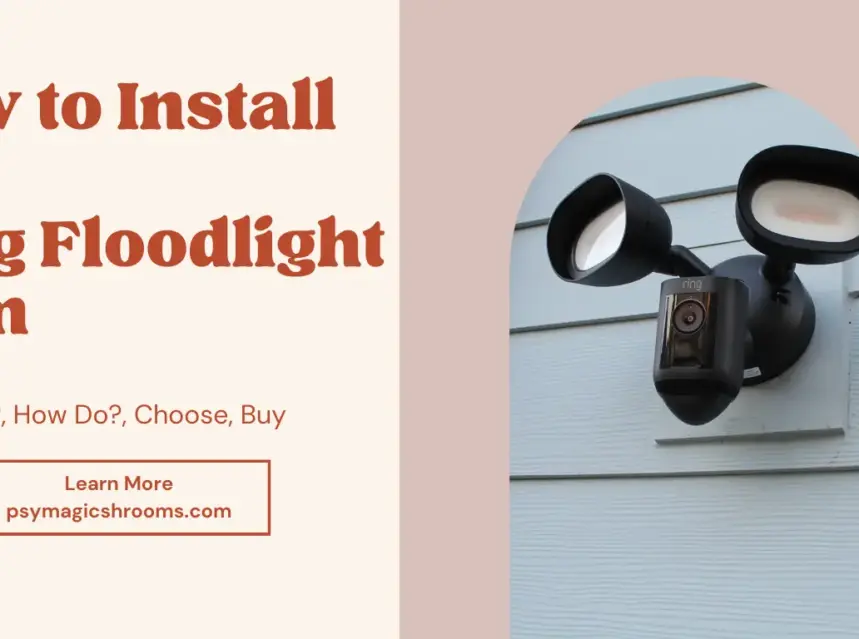How to Install Ring Floodlight Cam ⏬👇

Installing a Ring Floodlight Cam is a straightforward process that can greatly enhance your home’s security. This advanced outdoor camera not only provides crisp video quality but also doubles as a powerful motion-activated floodlight. Whether you’re a tech-savvy enthusiast or a novice DIYer, our step-by-step guide will walk you through the installation process, ensuring that you can enjoy the peace of mind that comes with having a Ring Floodlight Cam guarding your property. So, let’s get started on securing your home and illuminating the way with this user-friendly installation tutorial. “How to Install Ring Floodlight Cam“
What Is Ring Floodlight Cam?
The Ring Floodlight Cam is a versatile and advanced home security device designed to provide both surveillance and outdoor lighting for your property. This all-in-one device combines a high-definition camera with two powerful LED floodlights. Here’s what you can expect from the Ring Floodlight Cam:
- High-Quality Video: It offers crisp 1080p HD video quality, enabling you to monitor your property with clarity day or night.
- Motion Detection: Equipped with advanced motion sensors, the Floodlight Cam can detect movement and alert you to potential security threats.
- Two-Way Audio: It features a built-in microphone and speaker, allowing you to communicate with anyone on your property, whether it’s a visitor or a potential intruder.
- Remote Access: You can access the live video feed and control the device remotely through a mobile app, so you can keep an eye on your property from anywhere.
- Siren Alarm: In case of suspicious activity, you can activate a loud siren to deter intruders and alert your neighbors.
- Customizable Zones: You can define specific motion zones, ensuring you receive alerts for the areas that matter most to you.
- Integration: The Ring Floodlight Cam can integrate with other smart home devices, allowing you to create a comprehensive security system.
Overall, the Ring Floodlight Cam provides not only surveillance but also an effective deterrent against potential threats with its bright LED floodlights and built-in alarm. It’s a popular choice for homeowners looking to enhance their security and peace of mind.
How to Install Ring Floodlight Cam
Installing a Ring Floodlight Cam is a relatively straightforward process, but it does require some basic tools and electrical wiring skills. Here’s a step-by-step guide on how to install a Ring Floodlight Cam:
Tools and Materials You’ll Need:
- Ring Floodlight Cam
- Screwdriver (Phillips-head and flathead)
- Wire stripper
- Wire nuts
- Electrical tape
- Wire connectors
- Ladder
- Safety glasses
- Voltage tester (optional)
Installation Steps:
- Turn Off Power: Before you begin, turn off the power to the existing light fixture or junction box at your breaker panel. Use a voltage tester to ensure there is no electrical current.
- Remove Existing Fixture: If you have an existing light fixture or floodlight, carefully remove it by loosening the screws or nuts that secure it to the junction box. Disconnect the wiring but leave the wires exposed.
- Mount the Mounting Bracket: Attach the included mounting bracket to the junction box using the provided screws. Ensure it’s level and securely fastened.
- Connect the Wiring:
- Connect the black wire from the Floodlight Cam to the black or red wire from your junction box.
- Connect the white wire from the Floodlight Cam to the white or neutral wire from your junction box.
- If you have a green or bare copper grounding wire in your junction box, connect it to the green wire from the Floodlight Cam.
- Use wire nuts to secure the connections, and wrap them with electrical tape for added safety.
- Attach the Floodlight Cam: Carefully mount the Ring Floodlight Cam onto the mounting bracket. Secure it in place using the provided screws.
- Adjust the Light Heads: Position the light heads in the desired direction to illuminate the areas you want to cover.
- Connect to Wi-Fi:
- Download the Ring app on your smartphone if you haven’t already.
- Follow the in-app instructions to set up the Floodlight Cam on your Wi-Fi network. You’ll need to scan the QR code on the device.
- Configure Motion Detection:
- Customize your motion detection settings in the Ring app, including motion zones and sensitivity levels, to suit your preferences.
- Test the Floodlights and Camera:
- Turn the power back on at the breaker panel.
Test the floodlights and camera by triggering motion in the detection zones.
- Complete the Setup:
- Follow any remaining setup instructions in the Ring app, such as naming your device and setting up notifications.
Once you’ve completed these steps, your Ring Floodlight Cam should be successfully installed and ready to provide security and illumination for your property. Remember to periodically check and maintain the device to ensure it continues to function optimally.
Gather the Required Tools
To install a Ring Floodlight Cam, you’ll need a set of tools and materials to ensure a safe and successful installation. Here’s a list of the required tools and materials:
Tools:
- Screwdriver (Phillips-head and flathead): You’ll need these to secure the mounting bracket and connect wires.
- Wire Stripper: Necessary for stripping the insulation from wires for proper connections.
- Wire Nuts: These are used to secure electrical connections and prevent exposed wires.
- Electrical Tape: Use electrical tape to insulate wire connections and add an extra layer of safety.
- Wire Connectors: These help join wires securely and ensure a reliable electrical connection.
- Ladder: You’ll need a ladder to access the installation area, especially if it’s mounted high on a wall or ceiling.
- Safety Glasses: Always wear safety glasses when working with electrical components to protect your eyes.
- Voltage Tester (optional): A voltage tester can help you verify that the power is turned off at the junction box for added safety.
Materials:
- Ring Floodlight Cam: The main device you’re installing.
- Mounting Bracket: Usually included with the Ring Floodlight Cam or available separately.
- Screws: Provided with the Ring Floodlight Cam for attaching it to the mounting bracket.
- Existing Junction Box: If you’re replacing an existing fixture, you’ll need the junction box it’s connected to.
- Wiring: The electrical wiring in your existing junction box.
- Ladder: Ensure you have a stable ladder suitable for the height at which you’re installing the floodlight.
- Safety Glasses: Wear safety glasses to protect your eyes from dust and debris during installation.
Make sure you have all these tools and materials ready before you start the installation process. Safety should be a top priority, so if you’re not experienced with electrical work, consider hiring a professional electrician to assist with the installation.
Choosing and Buying Ring Floodlight Cam
Choosing and buying a Ring Floodlight Cam involves several steps to ensure you select the right model and make an informed purchase. Here’s a guide to help you through the process:
1. Determine Your Needs:
Consider your specific security needs. Do you want a single-camera setup, or are you looking for a multi-camera system for comprehensive coverage?
2. Research Ring Floodlight Cam Models:
Visit the Ring website or a reputable retailer to explore the various Ring Floodlight Cam models available. As of my last knowledge update in September 2021, Ring offered several options, including the Ring Floodlight Cam, Ring Floodlight Cam Pro, and Ring Spotlight Cam with Floodlight.
3. Features and Specifications:
Compare the features and specifications of different models. Pay attention to factors like camera resolution, field of view, motion detection capabilities, and night vision.
4. Compatibility:
Ensure that the Ring Floodlight Cam you choose is compatible with your home’s existing wiring and electrical setup.
5. Budget:
Determine your budget for the purchase. Ring offers various models at different price points, so choose one that aligns with your budget.
6. Read Reviews:
Look for customer reviews and expert opinions on the specific Ring Floodlight Cam model you’re interested in. This can provide valuable insights into its performance, reliability, and user-friendliness.
7. Installation Requirements:
Check if you have the necessary wiring and junction box for installation. Some models may require professional installation.
8. Warranty and Support:
Review the manufacturer’s warranty and customer support options to ensure you have reliable coverage in case of issues.
9. Mobile App Compatibility:
Make sure the Ring Floodlight Cam is compatible with your smartphone or tablet. You’ll need a compatible device to access the camera’s live feed and control its settings through the Ring app.
10. Purchase Options:
– Decide whether you want to buy the Ring Floodlight Cam from an official Ring dealer, a local retailer, or an online marketplace. Consider any deals, discounts, or bundles that may be available.
11. Additional Accessories:
– If needed, consider purchasing additional accessories, such as a solar panel for the Floodlight Cam’s power source or a Ring Protect plan for cloud storage and enhanced features.
12. Installation Services:
– If you’re not comfortable with DIY installation, check if Ring offers professional installation services in your area.
13. Compare Prices:
Compare prices from different sellers to ensure you’re getting a competitive deal.
14. Check Return Policy:
– Before finalizing your purchase, review the return policy of the seller in case you encounter any issues or need to make a return.
Once you’ve considered all these factors, you should have a clear idea of which Ring Floodlight Cam model suits your needs best. Proceed with your purchase, and after installation, you can enjoy enhanced security and peace of mind for your home.
Motion Detection Settings
Configuring motion detection settings for your Ring Floodlight Cam is essential to ensure that the camera only captures and alerts you to the movements that matter most to you while minimizing false alerts. Here’s how to adjust the motion detection settings using the Ring app:
1. Open the Ring App:
- Launch the Ring app on your smartphone or tablet.
2. Select Your Ring Floodlight Cam:
- Tap on the Ring Floodlight Cam from your list of devices to access its settings.
3. Access Motion Settings:
- Within the device settings, look for “Motion Settings” or a similar option related to motion detection. Tap on it to access the motion settings menu.
4. Customize Motion Zones:
- Many Ring devices allow you to create customizable motion zones. These zones determine where the camera should monitor for motion. Typically, you can drag and resize zones on a graphical map to focus on specific areas.
- Consider adjusting the zones to cover only the areas you want to monitor. Exclude areas with frequent motion, such as streets or busy sidewalks, to reduce false alerts.
5. Sensitivity Settings:
- You’ll usually find sensitivity settings that allow you to adjust how sensitive the camera is to motion. Options often include “High,” “Medium,” and “Low” sensitivity levels.
- If you’re receiving too many false alerts, try reducing the sensitivity level. Conversely, if you’re missing important motion events, increase the sensitivity.
6. Motion Frequency or Re-trigger Time:
- Some Ring devices offer an option to set a re-trigger time or motion frequency. This setting determines how long the camera waits before it can trigger another motion event.
- Adjusting this setting can prevent the camera from repeatedly capturing motion in a short time frame.
7. Light Settings (If Applicable):
If your Ring Floodlight Cam has built-in lights, you may have settings related to the lights’ behavior when motion is detected. For example, you can configure the lights to turn on for a specific duration when motion is detected.
8. Motion Scheduling (If Available):
Certain Ring devices offer motion scheduling, allowing you to set specific times when motion detection should be active or inactive. This can be useful if you want to disable motion alerts during specific hours, such as nighttime.
9. Test and Fine-Tune:
After making adjustments, save the settings and test the camera’s motion detection by walking through the monitored areas. Make further adjustments as needed until you’re satisfied with the camera’s performance.
10. Save and Exit:
– Save your customized motion detection settings, and exit the motion settings menu.
By customizing your Ring Floodlight Cam’s motion detection settings, you can tailor its behavior to your specific needs, reducing false alerts while ensuring that important events are captured and brought to your attention. Regularly reviewing and fine-tuning these settings can help optimize your camera’s performance over time.
Downloading and Using the Ring App Guide
Downloading and using the Ring app is an essential part of setting up and managing your Ring Floodlight Cam. Here’s a step-by-step guide to help you download and use the Ring app:
1. Download the Ring App:
- Open the app store on your smartphone or tablet. The Ring app is available for both iOS (Apple App Store) and Android (Google Play Store) devices.
- In the app store’s search bar, type “Ring” and press “Search.”
2. Install the App:
- Once you find the Ring app in the search results, tap on it to view the app’s details.
- Click the “Install” or “Get” button to download and install the app on your device. Follow any on-screen prompts to complete the installation.
3. Open the Ring App:
- After the app is installed, tap the “Open” button or locate the Ring app icon on your device’s home screen and tap it to launch the app.
4. Create a Ring Account:
- If you don’t already have a Ring account, you’ll need to create one. Tap the “Create Account” or “Sign Up” option within the app.
- Follow the on-screen instructions to provide your email address, create a password, and set up your Ring account.
5. Log In (If You Already Have an Account):
- If you already have a Ring account, tap “Log In” and enter your email and password to access your account.
6. Set Up Your Ring Device:
- Follow the on-screen instructions to set up your Ring Floodlight Cam. This may involve scanning a QR code on the device or manually entering device details.
7. Connect to Wi-Fi:
- During the setup process, you’ll be prompted to connect your Ring device to your Wi-Fi network. Follow the instructions to enter your Wi-Fi network name (SSID) and password.
8. Name Your Device:
- Give your Ring Floodlight Cam a descriptive name that helps you identify it within the app. For example, you can name it “Front Yard Cam” or “Backyard Cam.”
9. Complete the Setup:
- Once the setup is complete, you’ll be able to access your Ring Floodlight Cam’s live video feed, adjust settings, and receive motion alerts through the app.
10. Explore App Features:
- Take some time to explore the various features of the Ring app. You can:
- View live and recorded video footage.
- Adjust motion detection settings.
- Set up motion schedules.
- Receive real-time alerts.
- Speak through the camera using two-way audio.
- Share access with family members or trusted individuals.
- Enable cloud storage (Ring Protect Plan) for video history.
11. Customize Notifications:
- Within the app settings, you can customize how and when you receive notifications, ensuring they align with your preferences and needs.
12. Monitor Your Ring Floodlight Cam:
- You can now use the app to monitor your Ring Floodlight Cam from anywhere, receive alerts, and access recorded footage.
Remember to keep the Ring app updated to benefit from the latest features and security improvements. Additionally, refer to the app’s user guide or help section for detailed information on app features and troubleshooting tips if you encounter any issues.



